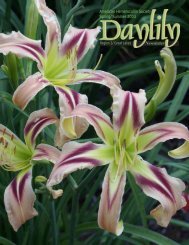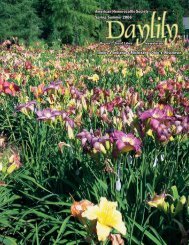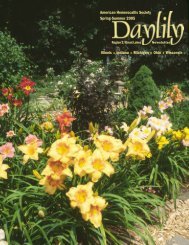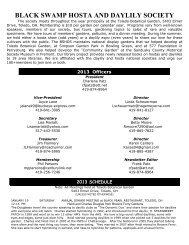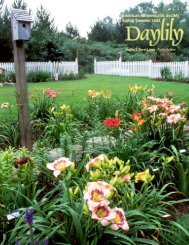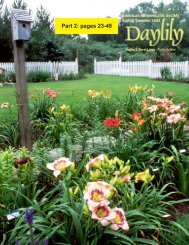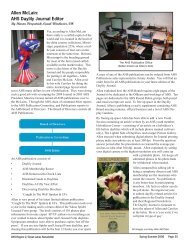Pages - AHS Region 2
Pages - AHS Region 2
Pages - AHS Region 2
You also want an ePaper? Increase the reach of your titles
YUMPU automatically turns print PDFs into web optimized ePapers that Google loves.
<strong>AHS</strong> <strong>Region</strong> 2/Great Lakes Newsletter<br />
The opportunity to address a captive<br />
audience, as it were, is just<br />
about irresistible. When I was invited<br />
to write a bit for the Newsletter,<br />
it seemed like a pretty simple<br />
thing to do. As it happened, as soon<br />
as I had said my diffident “probably<br />
yes” I found myself at a loss for<br />
words. Fortunately, the deadline<br />
for this issue was so far away at that<br />
moment that I was reasonably<br />
hopeful that something would occur<br />
to me by the time it was required.<br />
We suffer from a certain compulsion,<br />
most of us daylily lovers! We<br />
are addicted to the newest introductions<br />
from our favorite hybridizers.<br />
We daub pollen as though we knew<br />
what we were doing. We wait a<br />
couple of years to see the results,<br />
and then, reluctantly, trash almost<br />
all of them. I think we need to take<br />
a closer look at this condition of<br />
ours, and perhaps try for a little<br />
more detached perspective on ourselves.<br />
I’ll contribute to that with<br />
whatever little bits and pieces I can<br />
come up with.<br />
I suffer from another compulsion:<br />
the compulsion to count, list, measure,<br />
and tally everything in sight.<br />
We will take some peeks inside the<br />
world of data, using our dearly loved<br />
daylilies as the vehicle for our voyage.<br />
Hemerocoholicism<br />
How did we all get wrapped up in<br />
this compulsive addiction to Hemerocallis<br />
I have several theories, none<br />
of them flattering to us who are in<br />
the condition. We are just fortunate<br />
that there is an almost infinite number<br />
of varieties out there waiting to<br />
help us deal with our drives to collect<br />
ever more types of the daylily.<br />
We delude ourselves that daylilies<br />
are tough and self-sufficient, so that<br />
we are really not increasing the<br />
amount of work we have to do car-<br />
Page 18 Spring/Summer 2000<br />
Iconoclast’s Corner<br />
By Jim Shields, Indiana<br />
ing for our plants even if we do order<br />
30 or 50 new plants. If you<br />
choose carefully, not a single plant<br />
among those 50 new cultivars will<br />
be tough, let alone self-sufficient in<br />
our climate zones. The only self-sufficient<br />
daylily I ever saw was<br />
Hemerocallis fulva ‘Europa’, which<br />
can survive abandoned by the roadsides<br />
for a century or more.<br />
We convince ourselves that those<br />
new pinkish mauve flowers with the<br />
swollen, wrinkled edges of yellow<br />
are each unique and are all different<br />
and significantly better than the<br />
ones of similar appearance, but who<br />
are named differently from those we<br />
planted a year ago. Even worse,<br />
some of us actually manage to believe<br />
that the wretched things are<br />
beautiful.<br />
With the invaluable assistance<br />
of fellow members<br />
of the Daylily E-mail Robin and<br />
of <strong>AHS</strong> generally, we are going<br />
to build a set of observations on<br />
foliage that will help to settle<br />
the question – at least for the<br />
cultivars covered thoroughly<br />
enough in our surveys.<br />
You should help us out<br />
on this.<br />
We love beauty, we search for beautiful<br />
flowers, we crave the unique,<br />
the novel, the new. We spend ridiculous<br />
amounts of money for new<br />
introductions with the weak rationalization<br />
that we will make all that<br />
money back when we sell the future<br />
divisions of these expensive weeds.<br />
We vilify our friends and colleagues<br />
who dare to suggest that an occasional<br />
variety of these plants is less<br />
than totally hardy, less than totally<br />
desirable.<br />
The worst of us, typified by myself,<br />
make lists of the names of these<br />
things. The longer the list, the better<br />
we feel about it. In fact, the better<br />
we feel about the whole world.<br />
It’s really rather sad.<br />
Counting Everything in Sight<br />
I am in favor of counting and measuring<br />
everything not moving too<br />
fast to get a good look at.<br />
Let’s start with buds. Melanie Mason<br />
has suggested that bud counts<br />
on Florida plants decrease by 5 buds<br />
for every climate zone farther north<br />
in which we try to grow them. I<br />
think I may have suggested to<br />
Melanie that the bud count declines<br />
as an exponential function rather<br />
than a linear one, but Melanie’s hypothesis<br />
has priority of date. I wish<br />
we could say the converse was true<br />
of northern daylilies as you move<br />
them south. It’s too bad we can’t<br />
make that measurement too.<br />
However, we can certainly count the<br />
buds on our scapes. We don’t even<br />
have to count the buds on every<br />
scape nor on every variety we grow.<br />
Let’s just count the buds on the varieties<br />
that interest us the most.<br />
Join in and help us see if Melanie<br />
is on the right track!<br />
I am also dedicated to determining<br />
foliage habits for as many daylily<br />
cultivars as I can get our fellow enthusiasts<br />
to study. The hybridizers<br />
are generally pretty close on to<br />
the true condition, in my opinion.<br />
However, that is just my opinion; it<br />
is not a scientifically verified fact.<br />
With the invaluable assistance of<br />
fellow members of the Daylily E-<br />
mail Robin and of <strong>AHS</strong> generally,<br />
we are going to build a set of observations<br />
on foliage that will help<br />
to settle the question–at least for the<br />
cultivars covered thoroughly enough<br />
in our surveys. You should help us<br />
out on this.<br />
(continued on page 17)



